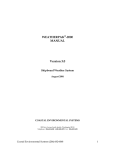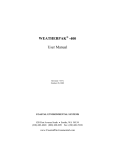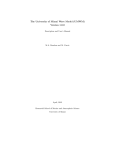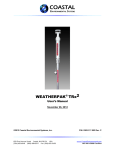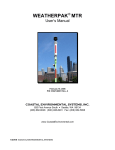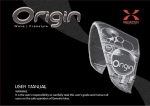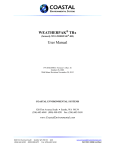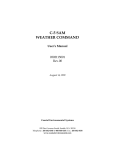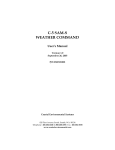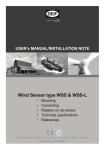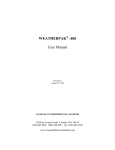Download c-5 sam /n weather command shipboard system
Transcript
C-5 SAM™/N WEATHER COMMAND SHIPBOARD SYSTEM USER’S MANUAL Rev. November 02, 2006 P/N: 0302115003 COASTAL ENVIRONMENTAL SYSTEMS, INC. 820 1st Avenue South, Seattle, WA 98134 Telephone: (206) 682-6048 / (800) 488-8291 Fax: (206) 682-5658 www.CoastalEnvironmental.com C-5 SAM/N User Manual Shipboard System TABLE OF CONTENTS 1.0 SETUP.................................................................................................................... 3 2.0 SHIPBOARD C-5 SAM/N DATA SPECIFICATIONS .................................... 4 2.1 OUTPUT DATA SPECIFICATION .................................................................. 4 2.1.1 Format: Serial ASCII code ........................................................................ 4 2.1.2 Message: Conform to NMEA 0183 ver 2.00 ............................................. 4 2.1.3 Definition: $WI Talker Identifier – Weather Instruments ......................... 4 2.1.3.1 Transducer Measurements ...................................................................... 4 2.1.3.2 Wind Speed and Angle ........................................................................... 4 2.1.4 Check Sum Value:..................................................................................... 5 3.0 INSTALLATION.................................................................................................. 6 3.1 SELECTING AN INSTALLATION SITE ........................................................ 6 3.2 INSTALLING THE SENSOR HEAD................................................................ 7 3.3 INSTALLING THE DISPLAY .......................................................................... 8 4.0 MAINTENANCE.................................................................................................. 9 4.1 SCHEDULED SERVICE ................................................................................... 9 4.2 C-5 SAM/N MAINTENANCE........................................................................... 9 4.3 WIND SENSOR MAINTENANCE ................................................................... 9 4.4 TEMPERATURE / RH SENSOR MAINTENANCE ...................................... 10 4.5 BAROMETER MAINTENANCE.................................................................... 10 4.6 CABLES AND CONNECTOR MAINTENANCE.......................................... 10 4.7 DISPLAY UNIT MAINTENANCE................................................................. 10 5.0 UNSCHEDULED MAINTENANCE ................................................................ 11 5.1 INSTALLATIONS PROBLEMS ..................................................................... 11 5.2 DISPLAY / NMEA OUTPUT FAILURE ........................................................ 11 5.3 SENSOR FAILURE ......................................................................................... 12 5.3.1 Wind ......................................................................................................... 12 5.3.2 Temperature / Relative Humidity ......................................................... 14 5.3.3 Barometer ................................................................................................ 14 6.0 SHIPBOARD WEATHER................................................................................. 16 6.1 A LITTLE MARINE METEOROLOGY......................................................... 18 6.2 SHIP INDUCED ERRORS .............................................................................. 19 6.2.1 Wind Errors ............................................................................................ 19 6.2.2 Temperature Errors ............................................................................... 20 6.2.3 Humidity Errors...................................................................................... 22 6.2.4 Barometer Errors.................................................................................... 23 6.3 CONTAMINATION BY SALT ....................................................................... 24 6.4 DATA AVERAGING METHODS .................................................................. 25 7.0 SCHEMATICS.......................................................................................................... 26 Coastal Environmental Systems (206) 682-6048 ii C-5 SAM/N User Manual Shipboard System IMPORTANT NOTE The nose cone of the wind monitor is removed (unscrewed) for protection against damage during shipment. Put the nose cone back on by screwing it to the wind monitor body. Since the nose cone has fine threads, make sure when you put the nose cone back onto the wind monitor body that it is not cross threaded. Coastal Environmental Systems (206) 682-6048 iii C-5 SAM/N User Manual Shipboard System C-5 SAM/N shown with optional Repeater (upper left) C-5 SAM/N showing all interconnections: top: side view of C-5 SAM/N display box (shown in top photo at bottom left), top-left: C-5 SAM/N power supply, bottom and bottomleft: optional Repeater and Repeater power supply. Coastal Environmental Systems (206) 682-6048 1 C-5 SAM/N User Manual Coastal Environmental Systems (206) 682-6048 Shipboard System 2 C-5 SAM/N User Manual Shipboard System COMMUNICATION GUIDE Shipboard C-5 SAM/N for Real-Time Systems 1.0 SETUP The C-5 SAM/N is a meteorological instrument, which samples continuously and outputs data at a set rate. The user can choose output formats and set the data output rate using a terminal connected to the C-5 SAM/N. This section describes the communication with the C-5 SAM/N. Set the terminal program in your computer as follows: Baud rate: Start bits: Stop bits: Data bits: Parity 4800 1 1 8 none Connect a test cable from the C-5 SAM/N to the serial port on your computer. The C-5 SAM/N will commence operation as soon as power is applied to the power connections on the test cable. INPUT POWER SPECIFICATION: Voltage: Current: 12 ± 1.5 VDC 0.9 Amp max (with radio) When power is applied the C-5 SAM/N will respond with a line of data like the one below. $--XDR, C, 26.0, C,, H, 44, P,, P, 1.0218, B, *1924, $--MWV, 4.2, R, 71, N, A*3314, Coastal Environmental Systems (206) 682-6048 3 C-5 SAM/N User Manual Shipboard System 2.0 SHIPBOARD C-5 SAM/N DATA SPECIFICATIONS 2.1 OUTPUT DATA SPECIFICATION 2.1.1 Format: Serial ASCII code 4800 baud 8 data bits 1 stop bit no parity 2.1.2 Message: Conform to NMEA 0183 ver 2.00 $WIXDR, C, x, C,, H, x, P,, P, x, B, *hh $WIMWV, x, R, x, N, A*hh 2.1.3 Definition: $WI Talker Identifier – Weather Instruments XDR Transducer Measurements MWV Wind Speed and Angle * Precedes check sum value hh Check sum value 2.1.3.1 Transducer Measurements Field 1 Field 2 Field 3 Field 4 Field 5 Field 6 Field 7 Field 8 Field 9 Field 10 Field 11 Field 12 Transducer 1 type, C, Air Temperature Transducer 1 Data Transducer 1 Units of Measure, C, degrees centigrade Transducer 1 ID, null field Transducer 2 type, H, Relative Humidity Transducer 2 Data Transducer 2 Units of Measure, P, Percent Transducer2 ID, null field Transducer 3 type, P, Barometric Pressure Transducer 3 Data Transducer 3 Units of Measure, B, Bars Transducer 3 ID, null field The characters following the “*” are a check sum. 2.1.3.2 Wind Speed and Angle Field 1 Field 3 Wind Angle (vane direction) in degrees Reference, R, Relative to vessel Coastal Environmental Systems (206) 682-6048 4 C-5 SAM/N User Manual Field 4 Field 5 Shipboard System Wind Speed Wind Speed Units, N, in knots The characters following the “*” are a check sum. 2.1.4 Check Sum Value: The checksum value is calculated by XOR’ing (exclusive OR’ing, also known as Modulo 2 Sum) the 8 binary data bits (not stop or start bits) of each valid data character in the sentence, between the “$” (HEX 24) and the “*” (HEX 2A). The delimiter “*” (HEX 2A) indicates that the face value of the following pair of ASCII characters represents the hexadecimal value of the upper and lower nibbles (4 bit values), respectively, of the checksum binary byte. The values of “$” (HEX 24), “*” (HEX 2A) and the alphanumeric value of the checksum following the “*” (HEX 2A) are not included in the checksum calculation. Coastal Environmental Systems (206) 682-6048 5 C-5 SAM/N User Manual 3.0 Shipboard System INSTALLATION The C-5 SAM/N is a sensitive instrument. It is rugged and reliable, but you must use care in placing it on the ship. Readings can be corrupted because of poor placement. 3.1 SELECTING AN INSTALLATION SITE 1. Read Section 6.0 about shipboard weather. Location on the ship affects measurement accuracy. Choose an exposed and uncontaminated site. 2. Stay forward of the stacks. Stay forward or above stack emissions. Diesel spray and exhaust particles will contaminate the sensors and dirty the C-5 SAM/N. 3. Avoid high vibration. The C-5 SAM/N is rugged, but continuous high vibration or other violent motion will reduce the lifetime of any instrument. 4. Locate as high as possible. The best location is as far forward and as high as possible. 5. Avoid high RF fields. Ships are great sources of radio frequency interference (RFI). Avoid the radar beam or other high fields. 6. Accessibility. The C-5 SAM/N will need routine maintenance so make sure it is located in an easily accessible place. Coastal Environmental Systems (206) 682-6048 6 C-5 SAM/N User Manual 3.2 Shipboard System INSTALLING THE SENSOR HEAD ____Choose the best location. ____Align the sensor head mounting post. The mounting post aligns towards the bow of the ship and parallel with the ships axis. A proper alignment is necessary for accurate wind direction measurements. ____Affix the mounting post to the ship. The post can be welded or clamped to the ship. The post must not rotate during use since this will affect the wind direction measurement. Be sure the alignment stays accurate while fastening the mount. The mount must be painted or otherwise protected any place that the paint has been removed by the mounting process. ____Locate a junction box for the cable connection within 1 meter of the top of the sensor head mounting post. This box will provide a place for the connection of the one-meter cable from the sensor head to the cable, which will be run through the ship to the display unit. ____Place the wind monitor propeller on the wind monitor and hand tighten the nylon nut to hold it on. The writing on the edge of the propeller blades should face into the wind. ____Place the sensor head on the mounting post and tighten the mounting screws in place. Use Never-Seize or equivalent grease on the threads of the screws to allow removal of the sensor head when maintenance is necessary. The sensor head will align to the bow of the ship when it is installed on the mounting pipe. ____Run the 1 meter cable from the sensor head into the junction box and temporarily seal the box and cable if the connecting cable is not yet ready to be spliced. Otherwise, splice the cable together and seal the box and cables. Coastal Environmental Systems (206) 682-6048 7 C-5 SAM/N User Manual 3.3 Shipboard System INSTALLING THE DISPLAY ____Determine where the display will be located on the bridge. ____The display mounts with four bolts through the box flange. Drill holes for the display and mount the display to the bulkhead. ____Determine the cable routing for the sensor head cable, the power cable and the NMEA 0183 data output cable. If the terminal strips are located on the wrong side of the box for easy cable routing, the box can be rotated so that the barometer port is up, and the display faceplate can be removed and rotated to be upright. Coastal Environmental Systems (206) 682-6048 8 C-5 SAM/N User Manual Shipboard System 4.0 MAINTENANCE 4.1 SCHEDULED SERVICE Scheduled service is best performed in port in mild and clear weather and with two people. LINE ITEM C-5 SAM/N SERVICE PERIOD (months) 6 Wind Monitor 6 Temperature Rel. Humidity 24 3 or less if dirty Barometer 6 Cables 6 4.2 SERVICE DESCRIPTION Check condition of case and base mount. Clean up. Check bearings for salt contamination or wear. Replace wind monitor if necessary. Check accuracy with deck sensor. Change the filter. Check accuracy using a sling psychrometer on the deck, if necessary. Check barometer against deck standard. Set offset if necessary. Inspect all cables for cuts, wear, or corrosion, Check MS connectors. C-5 SAM/N MAINTENANCE The C-5 SAM/N is a sealed weather tight assembly with no moving parts. The only maintenance required is to clean it and be sure all nuts and bolts are tight. ____ Clean the case of oil and stack deposit. ____ Check for minimal corrosion. ____ Check to be certain that the sensor head mount is firm with no wobble or vibration. 4.3 WIND SENSOR MAINTENANCE ____ Check bearings for resistance or wear. Replace sensor if necessary. ____ Verify speed and direction accuracy. Coastal Environmental Systems (206) 682-6048 9 C-5 SAM/N User Manual 4.4 Shipboard System TEMPERATURE / RH SENSOR MAINTENANCE _____ Replace the filter. ____ Verify sensor accuracy. 4.5 BAROMETER MAINTENANCE ____ Verify sensor accuracy. ____ Set offset if necessary. 4.6 CABLES AND CONNECTOR MAINTENANCE ____ Check connectors in the junction box. They should be free of any corrosion. Replace if necessary. ____ Check condition of waterproof tape and sealants. Replace if necessary. ____ Check cables for damage or wear. 4.7 DISPLAY UNIT MAINTENANCE ____ Brightness good. ____ Check all electrical connections. They must be clean and corrosion free ____ Check the barometer port to be sure there is no dirt or obstruction in the tube. Coastal Environmental Systems (206) 682-6048 10 C-5 SAM/N User Manual 5.0 UNSCHEDULED MAINTENANCE 5.1 INSTALLATIONS PROBLEMS Shipboard System System installed - nothing works! Problem: The system has just been installed but nothing happens. Most installation problems are the result of wiring errors and cable problems. Carefully check the wiring against the schematic to be sure no mistakes were made. There are two major parts to the C-5 SAM/N system: the sensor head and the display. Both parts must be operating for the system to work. 5.2 1. Check the power to system. Check the power to the system. The C-5 SAM/N uses the 12 VDC power at the display box. 2. Check power to display. If there is power to the display, it will light. Depending upon your display, you may see sensor data with asterisks instead of numerical output. If it doesn’t show anything, it may be defective. 3. Check the display to sensor head cable carefully for damage or misconnection. The C-5 SAM/N may function erratically or with very incorrect data values if only one or two of the wires damaged or mis-wired. DISPLAY / NMEA OUTPUT FAILURE This section assumes that the system has been installed properly and the cables are wired correctly. If anyone has just made changes to the C-5 SAM/N or the system, check those changes to be sure that they aren’t causing the new problem. If any parameters are changed in the C-5 SAM/N (whether intentionally or not), they could affect the operation of the system. Coastal Environmental Systems (206) 682-6048 11 C-5 SAM/N User Manual Shipboard System Display is dark. Problem: The display is dark – no visible characters or back light. Check the A/C power to the A/C to D/C power supply. If it is okay, check the D/C power out of the power supply. Check to be sure power is on the terminal strip. If there is power on the terminal strip and the display does not light, have the display serviced. Display lights, but no headings or numbers. Problem: The display lights, but either (a) no headings appear, or (b) there are headings but no numbers - only asterisks (***). If the display lights, it has power. Check the data light on the faceplate of the display. It should be off and flicker as data is updated every 10 or 11 seconds. If there is no flicker or there are bad data values, check the display to sensor head cable. If the cable is okay, have the display box and the sensor head serviced. Display works, but no data transfer. Problem: The display works but the Integrated Bridge System (IBS) is not getting data from the C-5 SAM/N. If the display works, the sensor head is working. Check for cable problems on the NMEA Tx lines to the IBS. If the Tx lines are okay, look for a problem in the IBS or the data format and baud rate. If no problem is found, have the display box checked. 5.3 SENSOR FAILURE This section assumes that the C-5 SAM/N and the display are functioning but some data value(s) appear to be in error. 5.3.1 Wind Wind speed is extremely low. Coastal Environmental Systems (206) 682-6048 12 C-5 SAM/N User Manual Shipboard System Problem: Wind speed is zero or extremely low. Visually check to see that the wind propeller is turning. The propeller could be broken or the bearings may be worn. Worn bearings would produce a zero or low wind value. If the propeller is turning, yet the wind speed is zero, a problem in the sensor wiring is likely. Replace the wind sensor. If this fails to solve the problem, the problem is most likely inside the sensor head or cables (assuming that other sensors are operating correctly). Wind direction zero, wrong or doesn’t change. Problem: Wind direction is zero, wrong or doesn’t change with the wind. Check the wind speed value. If there is not wind speed measurement, there will be no wind direction value (it will read zero). Visually check to see that the wind vane is not broken or obstructed. If the vane is freely moving, the propeller is turning and there is a zero for the direction – and you’re sure that the winds is not from dead ahead – a broken wire in the wind sensor is indicated. Replace the sensor. As above, if this doesn’t solve the problem, the problem could be inside the C-5 SAM/N. If the direction is wrong but the alignment pin is correct, call in a problem report. The C-5 SAM/N may have to be returned to the factory for repairs. The vane must rotate freely to track the wind. The vane is supported by bearings, which can wear or accumulate deposits preventing free rotation. Worn wind sensors can be repaired or replaced. Wind direction is always off by the same amount. Problem: The wind direction is always off by the same amount. The wind direction is reported as apparent wind. This is relative to the ships heading. When the sensor head mount was installed the guide pin had to be aligned to the bow. Check the alignment of the sensor head mount. If it is off, realign it. Coastal Environmental Systems (206) 682-6048 13 C-5 SAM/N User Manual Shipboard System 5.3.2 Temperature / Relative Humidity Temperature / Relative Humidity read extremes or never changes. Problem: Temperature and/or humidity sensor reads extreme low or high value, or never changes. A temperature or humidity value that is extremely low or high, or never changes readings, indicates a shorted or an open wire in the sensor or the C-5 SAM/N. Replace the sensor. If the problem persists, have the C-5 SAM/N tested. Temperature / Relative Humidity reads high or low, but changes. Problem: Temperature and/or humidity sensor reads high or low, but does change with the weather. A sensor can drift slightly over a period of time. If the drift is more than 1.0 deg C or 5% RH the sensor should be replaced. Be sure that the problem is not caused by the ship heating or cooling the sensor, or causing changes in the humidity. The humidity sensor is affected by salt or engine exhaust build-up more that the temperature sensor. Replace the filter on the sensor, or, if the sensor has no filter, gently clean any deposits from the sensing elements and install a filter. The sensor elements are extremely fragile, and care must be taken when cleaning them. 5.3.3 Barometer Barometer reads high or low constant value. Problem: The barometer reads high or low by a nearly constant value. The barometer must be corrected for the altitude above sea level of the C-5 SAM/N. This is a parameter which can be set in the C-5 SAM/N menu. If the barometer has been adjusted correctly, there may be a problem in the sensor or the sensor calibration values. Return the C-5 SAM/N for service. Coastal Environmental Systems (206) 682-6048 14 C-5 SAM/N User Manual Shipboard System Barometer is sometimes off. Problem: The barometer is sometimes wrong, but not always. The barometer can be affected by the wind blowing past the sensor. If the barometer value changes rapidly by large amounts, it could be defective; but check the reading when the wind is low. Barometer is way off. Problem: The barometer is off by a large error. If the barometer reads a negative number, it is either not installed or it has failed. If it has failed, replace it. If the barometer never changes value, or is giving a very incorrect value, then it may be out of calibration. The sensor should be replaced and tested and/or re-calibrated. Coastal Environmental Systems (206) 682-6048 15 C-5 SAM/N User Manual 6.0 Shipboard System SHIPBOARD WEATHER Do I trust the bridge or the C-5 SAM/N? You’re an experienced seaman with years at sea, and you know marine weather. You’ve used a bridge barometer, and you know how to reduce apparent winds to true winds (or you’ve seen it done). You are probably aware of the fact that ships have been taking measurements the same way since the Second World War. Suddenly, there’s a new computerized weather gadget called a C-5 SAM/N with readout on the bridge, right next to your old dials. Instant suspicion! What is this intruder, this C-5 SAM/N? Is it any good? Let’s see how it compares to my standard equipment. Aha! My bridge temperature says 5° but C-5 SAM/N says 2.5°. And look at this, my barometer (the one I’ve trusted for the past 15 years!) shows a flat 1000 millibars and C-5 SAM/N reads 996, a four millibar error! And finally the relative winds are way off, I’m reading 34 knots and C-5 SAM/N reads 40. So who do I believe? The instruments I’ve been looking at my entire career or this upstart? Believe ‘em both. The answer is that probably both readings are pretty nearly correct, and the errors you are seeing are caused by the ship and the wind around the ship. This section will explain how measurements of temperature, barometric pressure, winds, and humidity can vary all over a ship. They vary naturally on the open ocean anyway, then when the air flows around a ship they vary even more drastically. Of course it’s possible that one of the sensors can be bad, and this must be recognized. But familiarity, followed by understanding, is the crucial first step in the recognition process. Anyone who has been at sea has heard remarks such as “Oh, our wind direction is off by about 30 degrees; you can tell by the flag on the bow. I always add 30 degrees to my apparent direction.” That seaman is familiar with their equipment; (s)he has been watching it for months. Coastal Environmental Systems (206) 682-6048 16 C-5 SAM/N User Manual Shipboard System Familiarity takes time. The C-5 SAM/N represents an entirely new method of measuring meteorological quantities; it is the most significant advancement in weather observation at sea in the past 50 years. The numbers you read maybe different than your old equipment, but they are better measurements. The goal of taking measurements is to measure the air as if the ship was not there; as if the sensors were floating in space and not in any way affecting the air flow. This section explains the following: A. How marine meteorological quantities vary naturally; B. How the ship affects the air; and C. How placement of the C-5 SAM/N is essential to getting consistently good weather measurements (see also the installation section). We will try to explain what you can expect from the sensors you have and how best to install the C-5 SAM/N on your ship. Finally, we will talk briefly about the most crucial maintenance issues, which affect measurement accuracy. Often a little routine maintenance will provide surprising improvements. Coastal Environmental Systems (206) 682-6048 17 C-5 SAM/N User Manual 6.1 Shipboard System A LITTLE MARINE METEOROLOGY The Surface Layer Air blows over the ocean with a little gustiness. Even with large waves, to the air the ocean is as smooth as an ice covered lake. However, there is some friction and the wind near the surface is slowed down. In fact, the air right at the ocean is stuck to the surface and moves at the same speed as the ocean current at the surface. The air drags the water at the surface – this is what disperses oil spills. The water surface current is approximately 2-3% of the wind speed at 10 m height. For example, if the winds were 30 knots, an oil slick would move at about 0.3 knots (that’s 7.2 miles per day) just from the winds. Typically, the wind speed would change from 0.3 knots right at the surface to 30 knots at 10 m above the surface, and it could be as high as 45 knots at 40 meters above the surface. The exact relationship is complicated and scientists are still trying to understand it. “So,” you ask, “where do I measure winds, and who is right?” Wind speed, wind direction, temperature, and humidity all change in the vertical in a similar fashion – considerable change in the bottom 1-2 m and less change above that. From the ocean surface to a height of about 50 m is called the “surface layer”. However, above about 5 m height the change is very gradual except in very unusual conditions, such as very calm winds over cold water. So the guidelines from the World Meteorological Organization say that all ships measurements, except the barometer, do not need to be corrected for height before they are reported. The barometer correction is a simple added amount that depends on the height of the barometer above sea level (1 mbar per 8 meters of height). As we will see next, this applies for measurement made in free air, which is untroubled by the ship. The ship itself can cause significant variation in the measurements. Coastal Environmental Systems (206) 682-6048 18 C-5 SAM/N User Manual 6.2 Shipboard System SHIP INDUCED ERRORS 6.2.1 Wind Errors Into this untroubled air comes a ship, steaming at 5-30 knots. An observer on the ship feels the air coming from some direction. This wind is called the “apparent wind” because it is the wind relative to the observer on the ship. Usually the apparent wind is coming over the bow. Seamen know about the winds on a ship at sea. To windward the wind strength is felt. To leeward the wind speed drops and turbulence (gustiness) is felt as the wind breaks over the ship superstructure. The figure below shows a typical case of winds blowing around a ship. The lines with arrows are “streamlines”. Lines closer together indicate higher wind speeds and curly lines indicate turbulence. The numbers are of wind speed measurements if you had a sensor at that location. Ahead of the ship, before the wind “feels” the ship, the normal wind-ocean layer causes the speed to decrease from 20 to 30 m height to zero (nearly) at the surface. As the wind blows over the ship the streamlines get closer together meaning the winds speed up. Scientists call this “streamline compression” and the resulting increase in speed can be considerable. The errors certainly depend on the direction of the wind relative to the ship. Coastal Environmental Systems (206) 682-6048 19 C-5 SAM/N User Manual Shipboard System 6.2.2 Temperature Errors Temperature is both the simplest and the most difficult measurement to make properly. The temperature sensor is a simple thermistor (temperature dependent resistor) that is rugged and reliable. But there are so many different heat sources occurring naturally that one is never sure of their accuracy without taking the greatest of care. A few of the sources of error are given below. ♦ Ocean heating or cooling. If the ocean is much hotter or colder than the air, then a temperature surface layer, much like the wind surface layer, exists. Thus, from the surface to about 5 m height, one can see considerable variation. ♦ Sun Heating. The sun will heat up the sensor. We have a good shade screen over the temperature sensor, but even with that the sensor could heat by several degrees in a hot sun and with light winds. ♦ Ship Heating. The ship is generally hotter than the air or the water. Thus, as the air flows over the ship it will warm somewhat. Also the heat radiation from the ship will warm the sensor. Coastal Environmental Systems (206) 682-6048 20 C-5 SAM/N User Manual Shipboard System ♦ Wind Turbulence. As the wind flows around the ship it will move the air to different levels thus causing differences. ♦ Stack Gas. Stack gas is hot and moist – aside from being dirty – and can cause significant errors in temperature and humidity. ♦ Water on the sensor. If the sensor is wet, or if there are large pools of water around the sensor, then in the wind, evaporative cooling can alter the temperature. Coastal Environmental Systems (206) 682-6048 21 C-5 SAM/N User Manual Shipboard System 6.2.3 Humidity Errors Humidity (that is relative humidity) is the % saturation of the air; the amount of water it contains divided by the total it can hold without condensing. At the surface of the water the %RH = 100%. Higher up it will decrease to some steady value. As the air moves around the ship it carries the same water content it had before it encountered the ship. The RH % will increase all over the ship because the air is lifted in its trajectory. The vertical distribution of % RH depends on the original vertical distribution and the wind pattern over the ship. In the figure below there can be a 10% RH difference between the bridge and the mast. Coastal Environmental Systems (206) 682-6048 22 C-5 SAM/N User Manual Shipboard System 6.2.4 Barometer Errors The barometer readings can be affected by wind generating a dynamic pressure that adds or subtracts from the true atmospheric pressure (also called the “static pressure”). The exact amount of pressure error depends upon the wind speed; at high winds the error can be extreme. Wind tunnel tests show the barometer error inside a closed room with a single opening depending upon the location of the opening. The error is different if the opening is on the windward rather than the leeward side. Also, the error is different on a well-exposed pressure port mounted high on a mast – we expect the C-5 SAM/N to have this sort of error. The error in all cases increases by the square of the wind speed (meaning that if the wind speed doubles, the error increases by four times). The figure below is a typical case of wind caused dynamic pressure error around a ship. First, notice that the pressure decreases with height above, from (in this example) 1000 mbar at the surface to 994 mbar at a height of 30 meters. Therefore, with no wind errors the pressure at the top of the mast can be three mbar lower than the bridge reading. With a 20 knot wind blowing, the errors can increase to 6 mbar. Note also that opening or closing the wing doors on the bridge will cause the bridge barometer to change several millibars! Coastal Environmental Systems (206) 682-6048 23 C-5 SAM/N User Manual 6.3 Shipboard System CONTAMINATION BY SALT The marine environment is a salty environment. As the waves foam and break, droplets of water with salt are thrown into the air. These droplets can be very small and the wind turbulence can carry them to great heights. Obviously, when the winds are higher, the salt is carried to greater heights. At heights of 20 m and above, the air is relatively clear and the effects of salt are minimal. Below this height, salt buildup is a problem and regular maintenance should be done. One of the primary advantages of the C-5 SAM/N is that all the sensors are in the same package at a high position on the ship. Thus, contamination is minimal and problems are few. Any inconvenience experienced by having the sensors at altitude is more than made up for by the increased reliability and reduced maintenance requirements. Nonetheless, we should be aware of the problems caused by salt, and here are a few: ♦ Wind Monitor bearings. Over time the wind monitor bearings will collect salt and ultimately fail. When you spin the propeller or turn the vane of a new sensor, the bearings are smooth and have very low friction. After some time they will feel gritty from the salt. This generally not a problem, as long as the bearings turn reasonably easy, they will be giving good readings. The major effect of salt buildup will be to increase the “stall speed” of the wind monitor, the lowest wind that will still turn the propeller or turn the vane. ♦ Temperature sensor. Salt has little, if any, effect on the temperature measurement. The sensor is sealed and impervious even to immersion in salt water. ♦ Humidity sensor. Salt deposit will ruin the humidity sensor measurement, but not the sensor itself. Salt is “hygroscopic”, meaning it absorbs water. So a deposit of salt will cause the sensor to read a high humidity all the time. Coastal Environmental Systems (206) 682-6048 24 C-5 SAM/N User Manual Shipboard System We provide a protective filter for the RH sensor to keep out both salt spray and stack gas deposits. The filter should be replaced regularly. ♦ Barometer. The barometer is a simple strain gauge device with a sealed silicon pressure chamber. The chamber is exposed directly to the air through a coil of tubing that is designed to prevent rain from settling into the chamber. Salt will cause some corrosion in the chamber, but the lifetime of the sensor is several years. 6.4 DATA AVERAGING METHODS The measurements by the sensors are averaged in the C-5 SAM/N. Below is a brief description of the data processing that is done to produce the numbers you see on the display. Wind speed and direction. The winds are vector averaged during the sampling period (VS,VD). This means that for the averaging duration (typically 10 seconds) the wind speed and direction are sampled once per second. Each speed and direction pair are converted to a fore-aft wind and a cross wind, and these are averaged. At the end, the averaged winds are converted back to mean speed and direction. Air Temperature. The air temperature sensor is part of the temperature / RH sensor. The temperature is sampled each second and an average temperature (TA) is computed. Barometric Pressure. The barometer sensor is read several times each second during the averaging period and an average pressure (BP) is computed. Relative Humidity. The relative humidity sensor is read each second and the average of % RH (RH) is computed. Coastal Environmental Systems (206) 682-6048 25 C-5 SAM/N User Manual Shipboard System 7.0 SCHEMATICS Coastal Environmental Systems (206) 682-6048 26 C-5 SAM/N User Manual Coastal Environmental Systems (206) 682-6048 Shipboard System 27






























